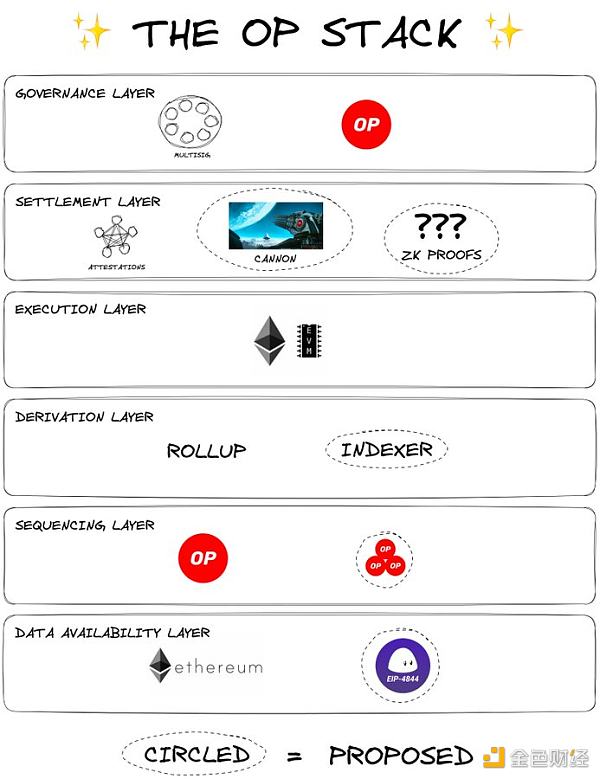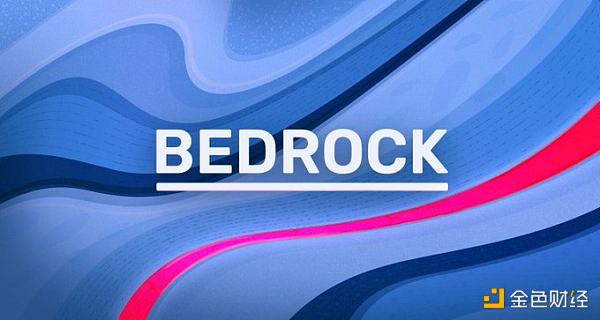Author: zerokn0wledge, Manta Network Ambassador; Translator: LianGuai0xjs
OP Superchain is the ultimate vision for Optimism’s scalability.
It has evolved into an independent ecosystem, primarily based on application-specific Rollups on OPStack, which can interoperate and combine with each other. Let’s take a look at the current situation of OP and how to achieve this goal!
Introduction: The Future of Multichain
It is currently widely believed that the future is multichain. However, many believe that it will not be cross-chain, as connecting multiple sovereign networks will bring too many issues.
- Overview of 1kx’s investment landscape in encrypted consumer applications What areas will be focused on in the future?
- Rollup Economics We Overestimated the Impact of EIP-4844 on Scalability
- Great Decoupling What are Blob and BlobsLianGuaice?
The traditional multichain architecture approach has two fundamental problems:
Each chain introduces a new security model, resulting in increasing system risks as new chains join the ecosystem.
The launch cost of new chains is high as they require new sets of validators and block producers.
These challenges are mainly due to the lack of a unified blockchain, i.e., an “L1” chain, as the consistent source of truth for all subsequent “L2” chains in the system. In theory, by establishing an L1 chain as a shared reference, standardized security protocols can be applied across all chains and the need for each chain to have independent sets of validators can be eliminated, as L2 chains can leverage the L1 consensus mechanism. This is exactly what Ethereum has done through Rollup expansion.
The Rise of OP Stack

As a solution to these challenges, Optimism introduces OP Stack. This development stack, powering Optimism, is a standardized and open-source framework for building Rollups, maintained under the supervision of Optimism Collective.
At its core, OP Stack includes software modules that define the specific layers of the Optimism ecosystem. While its current primary function is to facilitate L2 blockchains, its potential extends to higher layers, including tools such as block explorers, messaging protocols, governance frameworks, etc. The intention behind OP Stack is to establish it as a public good that benefits both Ethereum and the Optimism ecosystem.
Optimism Bedrock is the current version of OP Stack. It provides the necessary tools for launching industrial-grade Optimistic Rollup blockchains. But let’s explore it in more detail.
Optimism Bedrock: Features and Enhancements
 Bedrock represents a significant leap from its predecessor,
Bedrock represents a significant leap from its predecessor,
Reduced transaction fees: It significantly reduces transaction fees by optimizing data compression and using Ethereum for data availability. Preliminary data shows that this will greatly reduce costs. Additionally, Gas fees related to EVM execution are eliminated during L1 data submission, further reducing costs by approximately 10%.
Fast deposit time: Bedrock’s node software now supports L1 consolidation, reducing the previous maximum waiting time of 10 minutes to an estimated 3 minutes, greatly reducing the waiting time for deposits.
Modular Proof System: One key improvement of Bedrock is its ability to separate the proof system from the main stack, allowing Rollup to use fault or validity proofs (such as zk-SNARKs) to verify the validity of execution.
Higher Node Performance: Node software performance has been significantly improved. Now, nodes can execute multiple transactions within a single Rollup block instead of the previous “one transaction per block” protocol. Combined with improved data compression, this efficiency means that the average annual state growth has been reduced by about 15GB.
Higher Ethereum Compatibility: Bedrock’s design is closely related to Ethereum. This approach means that some deviations that existed in previous versions have been corrected, including the “one transaction per block” model, the unique opcode for accessing L1 block data, the separate fee structure for L1/L2 in the JSON-RPC API, and the custom representation of Ether balances.
Strategic Direction and Vision of the Superchain
The current OP Stack version (Bedrock) is designed to support the upcoming Optimism Superchain. The Optimism Superchain is envisioned as an interconnected L2 network, where these L2s share security protocols, communication frameworks, and a common development platform, which is the OP Stack itself. The core idea behind the Superchain is to have a set of standardized L2 chains, called OP chains, which together form a logical network. This system enables developers to create applications for the Superchain, bypassing the complexities of the underlying chains.

How Does Bedrock Support the Superchain?
SystemConfig Contract: This newly introduced feature aims to define L2 chains directly using L1 smart contracts. Its goal is to encapsulate all the details that define the L2 chains, including creating unique chain IDs and setting block gas limits.
Flexibility of Sorters: One unique feature of Bedrock is the ability to specify the sorter address through the SystemConfig contract. This innovation introduces the concept of modular sorting, allowing various chains with unique SystemConfig contracts to have their sorter addresses determined by deployers.
Data Availability (DA) Flexibility: Bedrock also provides flexibility regarding data availability (DA). This flexibility allows builders to choose optimized DA solutions, greatly reducing the costs compared to doing DA on Ethereum L1.
Multiple Proof System Support: Bedrock will adopt Cannon as its primary fault-proof mechanism. However, it still has flexibility to integrate with various optimistic and validity proof systems in the future. Having multiple proof systems ensures broader security and optimization options, enhancing the network’s resilience and adaptability.
Challenges on the Road to the Superchain
The expected success of the Bedrock Superchain release will be similar to the leap Optimism made in scalability and decentralization. However, it should be noted that there are still challenges to achieve a fully scalable blockchain ecosystem.
Challenges and Solutions for Withdrawal Application:
Currently, withdrawal application relies on a group of trusted chain validators. There is a possible solution to address this challenge: replace the trusted validators with fully on-chain proofs of dispute resolution, such as Cannon. However, relying solely on on-chain proofs carries inherent risks, especially without a backup mechanism. An innovative approach to bypass this vulnerability is to integrate a multi-proof system, which provides redundancy and ensures a stronger security network.
Cross-chain Transactions and Challenges with Challenge Period:
In cross-chain transactions, a major drawback of the challenge proof is that one must wait for a period called the challenge period to ensure the secure completion of the transaction. This waiting period can vary, affecting the speed of asset transfer between OP chains. On the other hand, validity proofs offer a solution to this delay problem. They eliminate the challenge period and pave the way for instant asset transfers. However, validity proofs primarily use zero-knowledge proofs (ZKPs), which are not only expensive but also prone to errors. It may still take a long time to promote ZKPs to the extent that they become the primary solution for cross-chain communication. However, the modular proof system of the OP Stack allows the simultaneous use of both proof systems, potentially supporting some interesting intermediate solutions. This dual system can achieve both low-latency bridging with lower security and high-security bridging with increased latency.
Therefore, developers have multiple bridging options, including:
-
High-security, high-latency challenge proofs.
-
Low-security, low-latency challenge proofs.
-
Low-security, low-latency validity proofs.
-
High-security, low-latency validity proofs, after ZKP productionization.
Solving Asynchronous Cross-chain Transactions:
A prominent issue is the asynchrony of cross-chain transactions, which disrupts atomic cross-chain composability. However, the potential for synchronous cross-chain message passing is introduced through the shared ordering protocol between OP chains. In this model, sorters on each chain achieve consensus on the inclusion of transactions, ensuring atomicity. Furthermore, transaction fees are only paid when successfully included on both chains, shifting synchronous risks from users to sorters. Implementing this shared ordering protocol on top of the sorting layer of the Bedrock superchain is feasible.
Scalability Issue of Submitting Transactions to the Superchain:
A significant challenge is the non-scalability of submitting transactions to the superchain, caused by the limited data capacity of L1. An innovative solution could be the Plasma protocol, which can expand the data availability of OP chains. This protocol enables alternative data availability (DA) providers, such as Celestia, to increase the limited L1 DA.
Growth of the Ecosystem

From the rapid expansion of the ecosystem of Rollups developed on top of it, we can see the attractiveness of OP Stack. Some notable examples include:
Base (Coinbase’s general L2), Mantle (BitDAO’s general L2, using EigenDA), Manta Network (general zk circuit, using Celestia for DA), OPBNB (general L2 settled on BNB Chain), Synapse Protocol Chain (cross-chain interoperability/bridging), ZORA (centered around NFTs), UniDex Finance (spot and perpetual contract exchange/aggregator), DeBank (social network/portfolio tracker), OPCraft (gaming), Aevo (derivatives)
Conclusion
In conclusion, the OP Stack and the accompanying vision of a superchain may change the path to a truly multi-chain future. Despite the remaining challenges, Optimism provides a hopeful solution that can lead us towards greater scalability and decentralization. If it continues to grow rapidly, we may see OP Stack consolidate its strong position through the inherent network effects of interoperability and composability offered by the superchain concept.
Like what you're reading? Subscribe to our top stories.
We will continue to update Gambling Chain; if you have any questions or suggestions, please contact us!